Avicenna (980-1037), a Persian physician and philosopher, wrote about the uses of hemp agrimony as a medicinal plant. This herb also was used by others who practiced Arabic herbal medicine in the early Middle Ages, primarily as an invigorating tonic and detoxifying agent.
The plant contains flavonoids, a benzofuran (Euparin), phenols, tannins, resin, and inulin. The essential oil extracted from hemp agrimony contains Thymol, Azulene, Cymene to name a few.
Cymene seems to have antiviral properties and the water-soluble polysaccharides found present in the herb are thought to stimulate the immune system in a positive way.
This herb has been used as an herbal remedy for viral infections such as colds and flu. Additionally it has been used to treat high fever.
Some recent studies have indicated that it could be helpful in treating cancer but more research is needed to confirm this.
Ailments such as poor bile flow, gallbladder inflammation, and gallstones have been treated by using this herb. It has otherwise been used for liver and biliary disorders and also to stimulate the excretion of toxins through the kidneys.
Hemp agrimony may be used internally as an herbal tea to increase appetite, for indigestion and to treat rheumatic disorders such as rheumatism and arthritis.
The root of the plant can act as both laxative and diuretic. Ingested in large doses the herb can be strongly laxative but in small doses, it can, in combination with other herbs, be used for constipation.
External uses of hemp agrimony, in the form of tincture, include treatments of minor skin infections, bleeding, bruising and wounds.
The leaves have been added to bread to prevent mold growth and vegetable juice made from the leaves has been rubbed into the fur of animals as an insect repelling agent.
[Read more about Hemp Agrimony…]

Leave a Reply